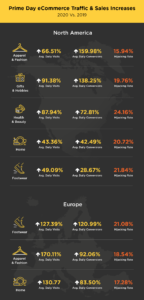This year’s Prime Day (last Wednesday and Thursday, October 13-14) was about much more than Amazon. For retailers across the board, it offered a first glimpse of what to expect from this year’s holiday shopping season. And it was the moment of truth for the speculation that the massive sales event would jumpstart the year’s peak period for eCommerce a full six weeks before Black Friday and Cyber Monday.
What did the results show? While they varied from industry to industry, the general trend is clear: This was not merely another Prime Day. In fact, the sales boost enjoyed by a wide variety of eCommerce companies was so remarkable that many retailers have decided to start their holiday promotions earlier this year.
To gauge the impact of this year’s Prime Day on the performance of non-Amazon retailers, we examined traffic and conversions for our eCommerce retail clients and compared them against last year’s Prime Day (July 15-16, 2019). Looking at our data from North America and Europe, here are some of the industries that saw the biggest increases in total online conversions this Prime Day as compared to last:

Unsurprisingly, these numbers show that all of these industries experienced an uptick in traffic as their online sales increased – although some industries saw the numbers of visitors jump more than others.
In addition, all of these industries saw that between 15% and 25% of their visitors’ sessions were compromised by Customer Journey Hijacking – an expensive problem in which online shoppers are targeted by unauthorized ad injections designed to lure them away.
How does this data help retailers?
The key takeaway for retailers and eCommerce companies is that now is the time to optimize their online shopping experiences and sales promotion strategies to make the most of the year’s peak sales period. With Prime Day falling much closer to Black Friday and Cyber Monday than in previous years, last week’s numbers suggest that Amazon largely pre-empted those sales holidays and created a longer peak season for eCommerce. Meanwhile, the retail giant itself reports that its third-party sellers made more than $3.5 billion this Prime Day – up almost 60% as compared to last year.
This year’s numbers also underscore why preventing Customer Journey Hijacking is such an important part of optimizing the online customer experience, especially in light of COVID-19.
As we typically see year-round, all of the industries listed above saw hijacking rates fairly close to 20% on Prime Day – meaning that around one in five visitors to their eCommerce websites was subjected to ad injections. And today – with retailers increasingly focusing on eCommerce, competition for online sales growing, and consumers more sensitive to price than in the past – the last thing retailers need from their websites is to promote their competitors. Moreover, with so many consumers still new to the world of eCommerce, online retailers now have a unique window of opportunity to foster customer loyalty.
In short, the KPIs we saw on Prime Day don’t just show that the sales event increased online sales well beyond Amazon. They show that now is the time for retailers to make sure they’re doing everything in their power to make the most of a holiday shopping season unlike any we’ve seen before.



